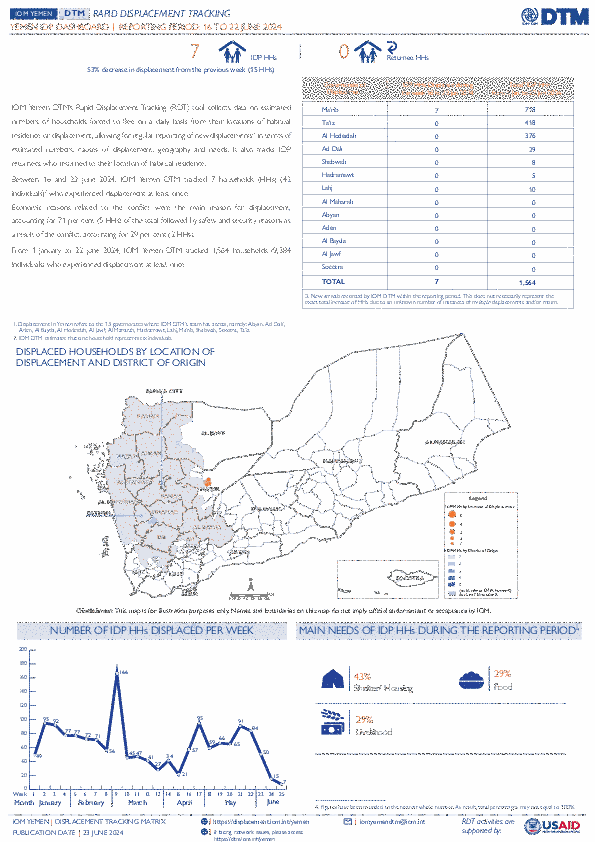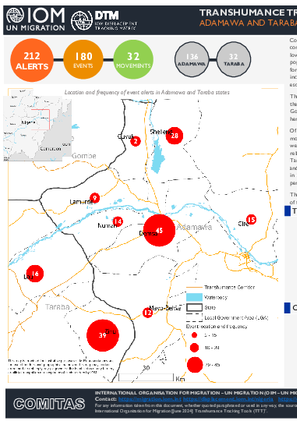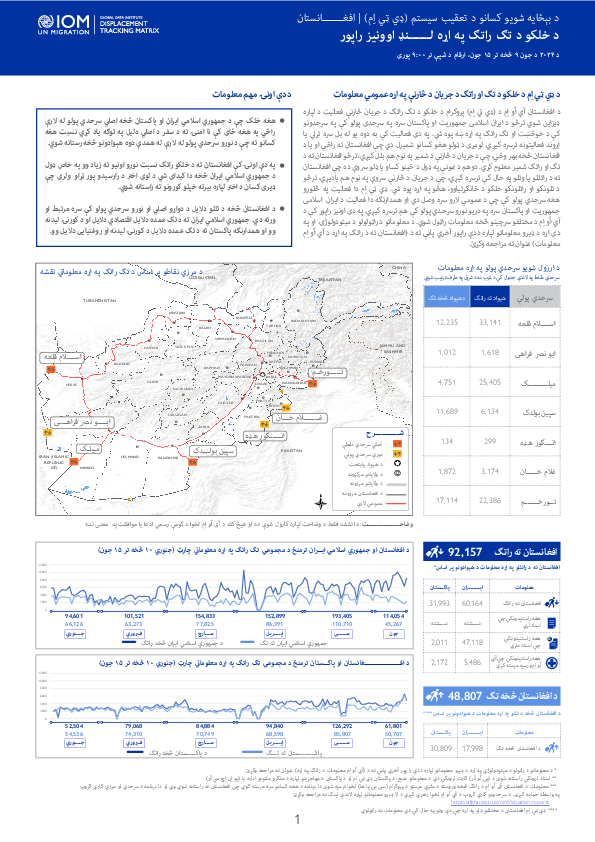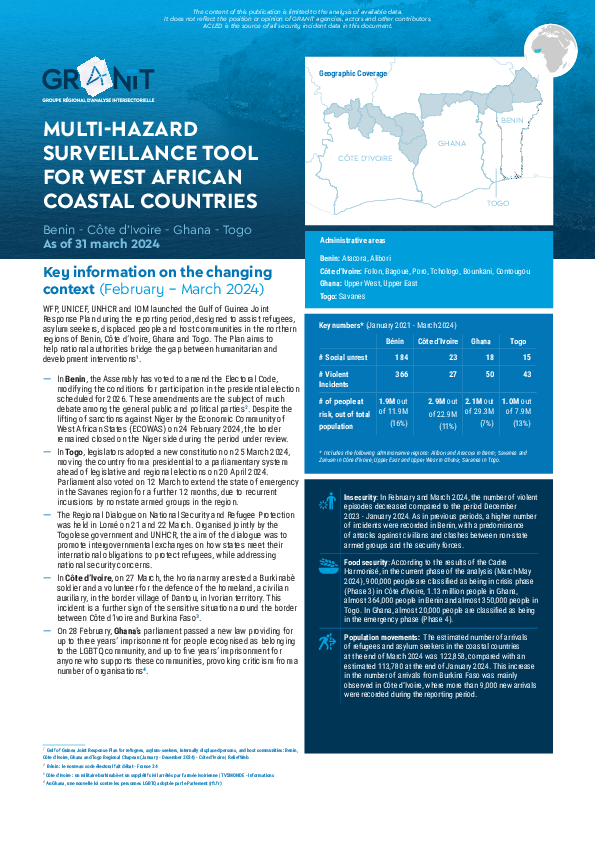-
Countries
-
Data and Analysis
-
Special Focus
-
Crisis Responses
Contact
DTM Yemen, iomyemendtm@iom.int
Location
Yemen
Activity
- Mobility Tracking
- Event Tracking
Period Covered
Jun 16 2024 -Jun 22 2024
From 1 January to 22 June 2024, IOM Yemen DTM tracked 1,564 households (HH) (9,384 Individuals) who experienced displacement at least once.
Between 16 and 22 June 2024, IOM Yemen DTM tracked 7 households (42 individuals) displaced at least once. The majority of people moved into/within the following governorates and districts:
- Ma’rib (7 HHs) – Marib City (4 HHs), Marib (3 HHs) districts. Most displacements in the governorate originated from Al Hodeidah and Dhamar.
The majority of people moved from the following governorates and districts:
- Al Hodeidah (2 HHs) – At Tuhayta (1 HHs), Ad Durayhimi (1 HHs) districts.
- Dhamar (2 HHs) – Otmah (2 HHs) district.
- Ta’iz (1 HH) – Al Qahirah (1 HHs) district.
Population Groups
IDPs
Returnee (Previously Internally Displaced)
Survey Methodology
Unit of Analysis Or Observation
Admin Area 2
Type of Survey or Assessment
Household
Key Informant
Keywords
Geographical Scope Partial Coverage
Administrative boundaries with available data
The current dataset covers the following administrative boundaries

Contact
DTM Yemen, iomyemendtm@iom.int
Language
English
Location
Yemen
Period Covered
Jun 16 2024
Jun 22 2024
Activity
- Mobility Tracking
- Event Tracking
IOM Yemen DTM’s Rapid Displacement Tracking (RDT) tool collects data on estimated numbers of households forced to flee on a daily basis from their locations of origin or displacement, allowing for regular reporting of new displacements in terms of estimated numbers, geography, and needs. It also tracks returnees who returned to their location of origin.
From 1 January to 22 June 2024, IOM Yemen DTM tracked 1,564 households (HH) (9,384 Individuals) who experienced displacement at least once.
Between 16 and 22 June 2024, IOM Yemen DTM tracked 7 households (42 individuals) displaced at least once. The majority of people moved into/within the following governorates and districts:
- Ma’rib (7 HHs) – Marib City (4 HHs), Marib (3 HHs) districts. Most displacements in the governorate originated from Al Hodeidah and Dhamar.
The majority of people moved from the following governorates and districts:
- Al Hodeidah (2 HHs) – At Tuhayta (1 HHs), Ad Durayhimi (1 HHs) districts.
- Dhamar (2 HHs) – Otmah (2 HHs) district.
- Ta’iz (1 HH) – Al Qahirah (1 HHs) district.

Contact
DTM Nigeria, iomnigeriadtm@iom.int
Language
English
Location
Nigeria
Period Covered
May 01 2024
May 31 2024
Activity
- Survey
- Mobility Tracking
- Event Tracking
Conflicts between farmers and herders in North-East Nigeria and other Sahel regions are driven by a combination of environmental and demographic factors, including desertification, climate change impacts, and low rainfall which reduces the availability of suitable land for farming and transhumance activities. Rapid population growth further exacerbates these issues by increasing the demand for food, shelter, and security for both humans and livestock. This heightened competition for scarce natural resources often leads to incidents like farming on cattle routes, crop destruction, farm damage, and water pollution, which often escalate into violent confrontations between farming and herding communities.
The Transhumance Tracking Tool (TTT), a component of IOM's Displacement Tracking Matrix (DTM with the support of community key informants) operationalized the Early Warning System in nine selected Local Government Areas (LGAs) in Adamawa and Taraba states. This system collects alerts related to farmer-herder conflicts.Of the 212 alerts recorded in May, 180 alerts (85%) were event-related, while 32 (15%) were related to movements. In Demsa, Lamurde, Girei, Shelleng, and Numan LGAs in Adamawa state, all instances of alerts were event-related. In Mayo-Belwa LGA, 92 per cent were event-related and 8 per cent were movement-related. Also, Guyuk LGA reported 17 per cent event-related alerts and 83 per cent movement-related. In Taraba state, Zing and Lau LGAs reported 83 per cent and 55 per cent event-related alerts, and 17 per cent and 45 per cent movement-related alerts, respectively. Disaggregated ward-level data indicates that Zing ward in Zing LGA in Taraba state and Kodompti ward in Numan LGA of Adamawa state reported the highest percentage of events, 8 and 7 per cent of the total alerts respectively.
Contact
DTM Yemen, iomyemendtm@iom.int
Location
Yemen
Activity
- Mobility Tracking
- Event Tracking
Period Covered
Jun 09 2024 -Jun 15 2024
From 1 January to 15 June 2024, IOM Yemen DTM tracked 1,557 households (HH) (9,342 Individuals) who experienced displacement at least once.
Between 9 and 15 June 2024, IOM Yemen DTM tracked 15 households (90 individuals) displaced at least once. The majority of people moved into/within the following governorates and districts:
- Ma’rib (15 HHs) – Ma’rib (10 HHs), Ma’rib City (4 HHs), Harib (1 HH) districts. Most displacements in the governorate originated from Al Hodeidah and Hajjah.
The majority of people moved from the following governorates and districts:
- Al Hodeidah (10 HHs) – Hays (3 HHs), Az Zaydiah (2 HHs), Al Mansuriyah (1 HH) districts.
- Hajjah (2 HHs) – Aflah Ash Sham (1 HH), Harad (1 HH) districts.
- Sana’a (1 HH) – Arhab (1 HH) district.
Population Groups
IDPs
Survey Methodology
Unit of Analysis Or Observation
Admin Area 2
Type of Survey or Assessment
Household
Key Informant
Keywords
Geographical Scope Partial Coverage
Administrative boundaries with available data
The current dataset covers the following administrative boundaries

Contact
DTM Yemen, iomyemendtm@iom.int
Language
English
Location
Yemen
Period Covered
Jun 09 2024
Jun 15 2024
Activity
- Mobility Tracking
- Event Tracking
IOM Yemen DTM’s Rapid Displacement Tracking (RDT) tool collects data on estimated numbers of households forced to flee on a daily basis from their locations of origin or displacement, allowing for regular reporting of new displacements in terms of estimated numbers, geography, and needs. It also tracks returnees who returned to their location of origin.
From 1 January to 15 June 2024, IOM Yemen DTM tracked 1,557 households (HH) (9,342 Individuals) who experienced displacement at least once.
Between 9 and 15 June 2024, IOM Yemen DTM tracked 15 households (90 individuals) displaced at least once. The majority of people moved into/within the following governorates and districts:
- Ma’rib (15 HHs) – Ma’rib (10 HHs), Ma’rib City (4 HHs), Harib (1 HH) districts. Most displacements in the governorate originated from Al Hodeidah and Hajjah.
The majority of people moved from the following governorates and districts:
- Al Hodeidah (10 HHs) – Hays (3 HHs), Az Zaydiah (2 HHs), Al Mansuriyah (1 HH) districts.
- Hajjah (2 HHs) – Aflah Ash Sham (1 HH), Harad (1 HH) districts.
- Sana’a (1 HH) – Arhab (1 HH) district.
IOM identified 12 additional households displaced in the previous reporting period, which covered 02 - 08 June 2024, in the governorates of Al Hodeidah (6 HHs), Ma’rib (4 HHs), Ta’iz (2 HHs). These figures have been added to the cumulative displacement total recorded since the beginning of the year.
Contact
dtmlebanon@iom.int
Location
Lebanon
Activity
- Mobility Tracking
- Baseline Assessment
Period Covered
Oct 10 2023 -Jun 11 2024
Since October 8 there has been an increase in cross-border incidents between Israel and Lebanon, resulting in the displacement of people both within the South and elsewhere within the country. Since October 10, the Displacement Tracking Matrix (DTM) has been conducting the daily monitoring of population movements. The objective of the exercise is to inform preparedness and response planning.
Population Groups
IDPs
Returnee (Previously Internally Displaced)
Survey Methodology
Unit of Analysis Or Observation
Admin Area 2
Admin Area 3
Household
Individual
Type of Survey or Assessment
Key Informant
Keywords
Geographical Scope Full Coverage
Administrative boundaries with available data
The current dataset covers the following administrative boundaries

Contact
DTMAfghanistan@iom.int
Language
Pashto
Location
Afghanistan
Period Covered
Jun 09 2024
Jun 15 2024
Activity
- Survey
- Flow Monitoring Survey
- Flow Monitoring
د افغانستان آي اُو اِم د (ډي تي اِم) پروګرام د خلکو د تګ راتګ د جریان څارنې فعالیت د لپاره ډیزاین شوي ترڅو د ایران اسلامی جمهوریت او پاکستان سره په سرحدی پولو کې په سرحدونو کې د خوځښت او تګ راتګ په اړه ښه پوه شي. په دی فعالیت کې به دوه یو له بل سره تړلي یا اړوند فعالیتونه ترسره کیږي. لومړی د ټولو هغو کسانو شمیرل دي چې افغانستان ته راځي او یا د افغانستان څخه بهر وځي، چې د جریان د څارنې د شمیر په نوم هم بلل کیږي، ترڅو افغانستان ته د تګ او راتګ شمیر معلوم کړي. دوهم د نمونې په ډول د ځینو کساو یا ډلو سروې ده چې افغانستان ته د راتللو یا وتلو په حال کې ترسره کیږي، چې د جریان د څارنې سروې په نوم هم یادیږي، ترڅو د تلونکو او راتلونکو خلکو د ځانګړتیاوو، هڅو په اړه پوه شي. ډي ټي اِم دا فعالیت په څلورو هغه سرحدي پولو کې چې د عمومي لارو سره وصل دي او همدارنګه دا فعالیت د ایران اسلامی جمهوریت او پاکستان سره په دریو نورو سرحدي پولو کې هم ترسره کیږي. په دی اونیز راپور کې د آي اُو اِم د مختلفو سرچینو څخه معلومات راټول شوي. د معلوماتو د راټولولو د میتودولوژۍ او په دی اړه د ډیرو معلوماتو لپاره ددې راپور آخري پاڼې ته د (افغانستان ته د راتګ په اړه د آي اُو اِم معلومات) عنوان ته مراجعه وکړئ

Contact
DTMAfghanistan@iom.int
Language
English
Location
Afghanistan
Period Covered
Jun 09 2024
Jun 15 2024
Activity
- Survey
- Flow Monitoring Survey
- Flow Monitoring
The IOM Afghanistan’s DTM Flow Monitoring activity is designed to provide insights into the mobility patterns at Afghanistan’s border points with the Islamic Republic of Iran and Pakistan. The activity involves two interlinked exercises: the Flow Monitoring Counting (FMC), a headcount of individuals crossing the border, and the Flow Monitoring Surveys (FMS), which collect data on the profiles and intentions of randomly selected Afghan nationals. DTM FM is operational at four main crossing points (connected to Afghanistan’s National Highway) as well as three other crossing points with Islamic Republic of Iran and Pakistan. This weekly snapshot combines information from the FM activity and various IOM sources related to cross-border movement. For a detailed explanation of the methodology used in gathering this data, the report directs readers to the section titled “IOM INFLOW DATA” on the last page.
The GRANIT was conceived in 2021 in Dakar at the initiative of OCHA, IOM and REACH with the support of the Regional Sectoral Groups, UN agencies and NGOs. GRANIT seeks to create a forum of technical experts and information managers to pave the way for a regional, holistic and cross-sectoral analytical approach to inform the crisis preparedness and response phases. The aim of the monitoring tool is to track developments in the context in the target countries, using a multi-hazard approach. To this end, 15 indicators have been selected by the regional group of experts in emergency preparedness and response and GRANIT members. This report presents the evolution of the situation in Benin, Côte d'Ivoire, Ghana and Togo, as of 31 March 2024.
This document is a compilation of data collected by IOM from FRONTEX as well as the Italian, Spanish, Greek, and Maltese interior ministries on migratory movements from Africa to Europe between 2017 and 2023. IOM works closely with a wide range of actors, including government and non-government partners, to collect and compile this data every quarter. This document presents the situation of migrant arrivals in Europe based on data between 2017 and 2023 from the point of view of movements from West and Central Africa (WCA).


